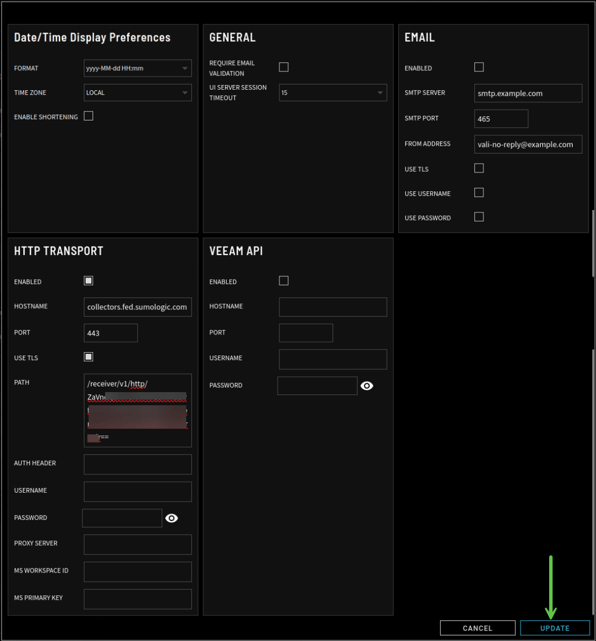How to Configure ZeroLock® Management Console to Send Activity Data to Splunk Cloud, Sumo Logic, and Microsoft Sentinel_v4.1.x
This article will walk through configuring the ZeroLock Management Console (ZMC) to send all data from the Activity Log to Splunk Cloud, Sumo Logic, and Microsoft Sentinel via Log Analytics Workspace.
The data collected in an Activity Log is critical for system administrators in monitoring events, troubleshooting issues, and ensuring security. Everything from user activity, endpoint events, and information on alerts (Alert ID, Type of alert, links to specific alerts) is collected in the log. For example, an administrator can see detailed SSH-MFA alert data such as the success/failure of the attempts, the source IP address, and the hostname with the date and time of the event.
Configure the ZMC
To configure the ZMC for sending data to Sumo Logic or Splunk Cloud, go to System Configuration | System Settings, then EDIT on the HTTP Transport section.

Selecting EDIT brings up that section’s edit screen.

Splunk Cloud
ZeroLock uses Splunk’s HTTP Event Collector to send data to Splunk. To create the HTTP Source collector from the Splunk console, go to Settings | Data inputs and select Add New in the HTTP Event Collector row.

Configure the ZMC
- Enter the Hostname. This is the name of the Splunk server you plan to use. This can be found by looking at the URL when logging into your Splunk Cloud console.
In this example, it is: prd-p-xo8sh.splunkcloud.com

- Enter the Port. By default, this is usually 443 for Splunk Cloud deployments or 8088 for a demo instance. In this example, it is: 8088.
- Enter the Path. By default, this will usually be /services/collector/event
- Enter the Auth Header. This can be found by going to Settings | Data inputs in the Splunk Cloud console.

- On the Data Inputs screen, select the HTTP Event Collector.

- This will list the Event Collectors configured, as shown below.

- Copy the Token Value for the selected collector into the ZMC and append “Splunk” to the beginning of it.

In this example, it is:

- On the Data Inputs screen, select the HTTP Event Collector.
- Check ENABLED. This enables the HTTP Transport.


- Click the UPDATE in the ZMC to save the settings.

You have successfully configured the ZMC to write to the Syslog using Splunk.
Sumo Logic
Sumo Logic HTTPS Source collector must be set up to allow the ZeroLock Management Console (ZMC) to send data. Directions on creating and managing an HTTPs Source collector can be found on the Sumo Logic knowledge base.
Configure the ZMC
- Enter the Hostname. This is the name of the Splunk server you plan to use. This can be found by clicking Show URL from the configured collector in Sumo Logic.

In this example, the URL is:
The Hostname is collectors.fed.sumologic.com.
- Enter the Port. This should be 443 by default.
- Enter the Path. This is part of the URL, after the Hostname, that was collected in step 1. In this example, it is:

- Check ENABLED for HTTP Transport, and you have completed the HTTP Transport section.

- Click the Update button in ZMC to save the entered settings.

Microsoft Sentinel
- Enter the Hostname. The value is: https://<workspace-id>.ods.opinsights.azure.com, where <workspace-id> is replaced by the actual id for the workspace. This can be retrieved from the agent's settings for the workspace in Azure here:

For example, if the workspace id is: 2f8b4e90-3a13-4d3b-91a9-5d9e6a71b9e4, then the hostname value would be: https://2f8b4e90-3a13-4d3b-91a9-5d9e6a71b9e4.ods.opinsights.azure.com - Enter the port. This value is usually: 443.
- Make sure that Use TLS is checked.
- Enter this for the path: /api/logs?api-version=2016-04-01
- Enter the MS Workspace ID. This was retrieved in step 1.
- Enter the MS Primary Key. This can be retrieved from the agent settings for the workspace in Azure here:

Example Primary Key: rL3mU8j+5kYqX4pU9sWvZmP3AvqK/XLK1Yf4Vn9Ns14FoO0KYZKx0UOiX3AvcFqvP3Y3s5OJoW2f4Wv8dz9kOg==
- With these examples, your ZMC HTTP Transport section should look like this:

- When these events are sent, a table (ZMCLog_CL) will be added to the Custom Logs section in Azure under the Logs category in Log Analytics Workspace.

- After selecting this table in Azure, you should see data as it is sent to the Log Analytics Workspace from the ZMC.

You have successfully configured ZeroLock® Management Console to write to Splunk Cloud, Sumo Logic, and Microsoft Sentinel.
NOTE:
Support for MS Sentinel is effective with ZeroLock Management Console v4.1.10.